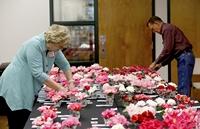Emily Mavrakis @emmavrakis Jan 5, 2020 at 2:03 PM The Gainesville Camellia Society displayed more than 1,500 flowers at its annual show over the weekend. Randi Terry and Meri-Lin Plantanida packed up their Jeep full of plants Sunday morning before heading back home to Florahome, in Putnam County, with additions to their growing collection of camellias. “This time of year, it’s the only thing that blooms,” said Terry, who has been growing camellias for about a decade now. Over the weekend, the Gainesville Camellia Society sold 700 plants at its annual sale and show at Kanapaha Botanical Gardens, 4700 SW 58th Drive. Society President Bruce Cavey said camellias captivate many gardeners and homeowners in North Florida and Southern Georgia because they grow so well. “This is a phenomenal place to grow camellias because of our soil conditions,” he said. Gainesville’s soil is sandy loam, which drains well, Cavey said. Additionally, the region’s temperature closely resembles that of its native land, China. Inside Kanapaha’s main entrance building, more than 1,500 camellia blooms lined tables in reds, whites, pinks and speckled variations. One of the rarest colors, Cavey said, is yellow. Avid growers are working to develop a pure yellow hue, but those produced and displayed over the weekend were paler. Cavey, who has been gardening for nearly 50 years, said what draws him toward camellias is their history. When they originated in China, only priests and aristocrats grew them for their lovely blooms. Everyday people used the plant’s oil for cooking and heating. It burns quickly in high heat. It was brought to the United States by way of trade with England, through Charleston, South Carolina. From there, camellias found their home in Georgia and Florida. Some homes and former plantations have maintained camellias on their property for several generations. Aside from their rich history, Cavey can’t deny that the blooms are just plain beautiful. “To have that kind of color in your landscape, it’s an instant morale booster,” he said. “Some just don’t even look real.” More than 250 species and thousands of varieties exist, Cavey said, and more […]






